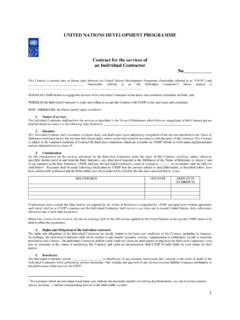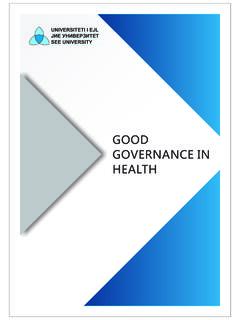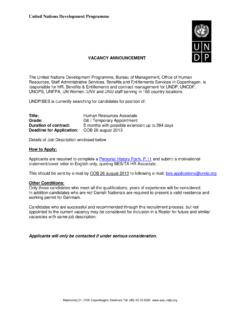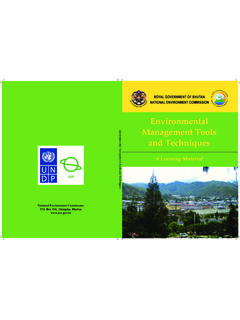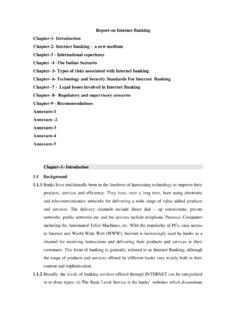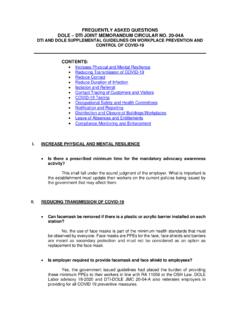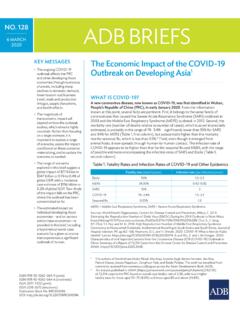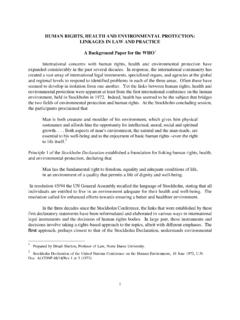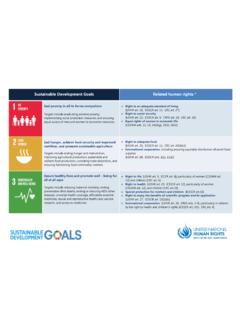Transcription of HOW TO CONDUCT A GENDER ANALYSIS
1 HOW TO CONDUCT . A GENDER ANALYSIS . A GUIDANCE NOTE FOR UNDP STAFF. United Nations Development Programme Bureau of Policy and Programme Support GENDER Team 2016. INTRODUCTION. The UNDP Strategic Plan places special emphasis on GENDER equality and the empowerment of women. The SP integrates GENDER concerns into six of its outcomes, and GENDER equality is the sole focus of outcome 4. UNDP GENDER Equality Strategy, 2014-2017 provides strategic guidance to UNDP business units to mainstream GENDER as they operationalize the UNDP Strategic Plan (SP), 2014-2017. To achieve SP goals all UNDP country programmes and projects should include specific measures to address GENDER inequalities and GENDER (and sex) disaggregated data and indicators. In 2015, the UNDP Independent Evaluation Office (IEO) conducted a thematic evaluation of the contribution of UNDP to GENDER equality and women's. The evaluation found that UNDP has yet to develop a firm corporate policy that ensures GENDER ANALYSIS is a mandatory requirement in all programming , and recommends that UNDP should focus on refining tools, instruments and processes developed during the period 2008-2013 and focus on further internalizing the centrality of GENDER equality and women's empowerment to the achievement of all development goals among staff.
2 This tool intends to respond to the 2015 evaluation. The guidelines are designed for programme staff in charge of formulating and implementing programmes and projects. It intends to help project managers to ensure that GENDER issues are systematically integrated at each stage of the project cycle. It will also help to meet the Project Quality System (Q&A) requirements at all stages of the project. The tool is divided into two parts: the first part presents what is GENDER ANALYSIS as a tool and how to use it to assess the differences in the lives of women and men, girls and boys and the relationships between and amongst them. The second part provides guidance on how to apply GENDER ANALYSIS in Projects. Finally, it includes an example of Terms of Reference to commission a GENDER ANALYSIS for programming. UNDP would like to acknowledge that material has been drawn from different institutions and organizations. We thank all UNDP colleagues to make this practical guideline possible.
3 Author: United Nations Development Programme Published: 2016. TABLE OF CONTENTS. 1. GENDER ANALYSIS : What you need to know .4. What is a GENDER ANALYSIS and what does it tell us? .. 4. resources do we need for an effective GENDER ANALYSIS ? .. 5. Why the GENDER ANALYSIS is linked to results based management cycle of the UNDP. programmes/projects? .. 5. When do we use a GENDER ANALYSIS ? ..5. What information a good GENDER ANALYSIS should provide? .. 6. 2. GENDER ANALYSIS in ..7. Develop a Situational ANALYSIS ..7. Use GENDER ANALYSIS to develop your intervention strategies (theory of change and Project priorities ..8. Results Framework .. 10. Budget and Work Plan .. 12. Monitoring and Evaluation ..13. 3. Annexes .. 15. Annex I: Essential Concepts in GENDER ANALYSIS ..15. Annex II: Resources .. 16. Annex III: General Information for Terms of Reference to commission a GENDER ANALYSIS for programming .. 18. 2. I. GENDER ANALYSIS : WHAT YOU NEED TO KNOW. It is important to be clear about why and when to perform the ANALYSIS , what the scope entails, who is to be involved and the amount of time and other resources you have to provide.)
4 WHAT IS A GENDER ANALYSIS AND WHAT DOES IT TELL US? GENDER ANALYSIS is the critical starting point for GENDER mainstreaming: The first step in a mainstreaming strategy is the assessment of how and why GENDER differences and inequalities are relevant to the subject under discussion. Without it GENDER mainstreaming is not possible. GENDER ANALYSIS is a tool that What is a GENDER ANALYSIS ? brings to the surface GENDER disparities of a core problem. It An intrinsic dimension of policy ANALYSIS reveals the connections between GENDER relations and the Identifies specifically how public policy development challenge to be affects women and men differently solved, it indicates exactly what Demonstrates that policy and that impact is likely to be, and implementation cannot be GENDER neutral promotes alternative courses of in gendered societies action. It is supported by specific analytic tools GENDER ANALYSIS is a systematic analytical process based on sex-disaggregated and GENDER information.
5 This process is used to identify, understand, and describe GENDER differences and the relevance of GENDER roles and power dynamics in a particular context. A GENDER ANALYSIS helps ensure equitable participation of women and men in development processes and projects. In some cases, GENDER issues may be significant to the process/project, and play a determining role in outcomes. In other instances, they may be less significant, and constitute rather a set of factors to be weighed with others. It should show the linkages between inequalities at different societal levels. Don't forget that neither women nor men form a homogeneous group. GENDER relations intersect with many categories of social identities, such as religious, political affiliation, ethnicity, social status, age, and sexual orientation. If we don't make those linkages explicit we run the risk of reinforcing existing imbalances. 3. WHAT RESOURCES DO WE NEED FOR AN EFFECTIVE GENDER . ANALYSIS ? 1. Specialized expertise in GENDER issues and/or sector-specific needs, and an allocation of financial resources for analyses.
6 Access to national GENDER statistics, and operations research ( , findings derived from testing pilot projects, and from programme monitoring and evaluation). Access to qualitative data generated through policy and academic research and participatory assessments. WHY IS THE GENDER ANALYSIS LINKED TO THE RESULTS BASED. MANAGEMENT CYCLE OF UNDP PROGRAMMES/PROJECTS? The results of the GENDER ANALYSIS are the foundation for taking GENDER into account in all steps of a project cycle. Conducting a GENDER ANALYSIS whether in the design phase or at another point in the project term produces recommendations2 to: 1. Answer questions in regard to the (baseline) situation. 2. Develop a GENDER -responsive theory of change and devise a methodological approach. 3. Include GENDER issues within the scope of projects and programmes 4. Make necessary changes to the monitoring system. When you link GENDER ANALYSIS to the result-based management cycle of development measurements it also provides a basis for assigning the GENDER marker.
7 Even if a project or programme does not include GENDER relevance and is scores GEN 0, the decision to assign this marker must be based on the results of the GENDER ANALYSIS . WHEN DO WE USE A GENDER ANALYSIS ? GENDER ANALYSIS can be done any time we are looking for ways in which to better understand and improve our programmes/projects. However, there are definitely situations that present more opportune moments to execute a GENDER ANALYSIS such as: 1. Adapted from UN Women, 2014. 2. GIZ, 2011. 4. During the initial design of a project Before the implementation of a policy During the midterm review and evaluation of a project or policy Overall, we use a GENDER ANALYSIS when we need to develop a comprehensive situational ANALYSIS or increase our understanding of GENDER issues and challenges in the countries we work. For example, we implement a GENDER ANALYSIS when we want to better understand3: Levels of participation and involvement of women and men, in the labor market, community decision-making, and use and control over natural resources Different experiences of specific development challenges such as poverty, migration, gang violence, etc.
8 Different outcomes from the same intervention, education, health services, land titling Barriers and constraints to full participation by different groups, in decision-making Specific vulnerabilities and inequalities, single-female headed households, rural women, women with disabilities etc. Cultural and social patterns of behavior that appear to be direct opposition to the interests of certain individuals and groups, taking girls out of school earlier than boys. WHAT INFORMATION SHOULD A GOOD GENDER ANALYSIS PROVIDE? 4. The GENDER ANALYSIS can be conducted from the grassroots levels (the micro level), intermediate levels (meso level), the highest political levels (macro level), and across all sectors and programmes of development collaborations. A good GENDER ANALYSIS helps us to better understand: How the GENDER division of labour and patterns of decision-making effect programmes/projects, and vice versa how programmes/projects effect the GENDER division of labour and decision- making.
9 GENDER differentials in activities surrounding access to control over resources such as income, time, technologies and services. In addition, it helps us identify who has greater means to access 3. Source: United Nation Development Group, 2014. 4. Resources: Adapted from: UNDP (2007), USAID (2011), UNDP (2015), EC (2009), NZAID (2006). 5. opportunities, for example in regards to land, livestock, financial services, health and education, employment, information and communication, and benefits Power and Decision Making. This set of information refers to people's ability to decide, influence, control, and enforce individual and governmental power. It examines the capacities of existing institutions and the mechanisms in place to reach out equitably to girls and boys, women and men, and to promote GENDER equality among target groups. It also refers to one's capacity to make decisions freely, and to exercise power over one's body, whether in one's household, community, municipality, and state.
10 Legal rights and status. This dimension involves assessing how women and men are regarded and treated by customary and formal legal codes, and the judicial systems. This includes an assessment of state issued documentation such as identification cards, voter registration, and property titles. Furthermore, a substantive evaluation will include the right to inheritance, employment, atonement of wrongs, and legal representation. Women's priorities, restraints and motivations: This category includes a review of the different, but equally significant, needs and interests of women and men; depictions of the barriers faced by women in seeking to meet their practical and strategic GENDER interests; an identification of opportunities for greater equality and empowerment for women. Time. This area of information recognizes GENDER differences surrounding various needs of availability and allotment of time. It examines the implications that GENDER differences have on commitments and in turn the effects on poverty and work-life balance.
